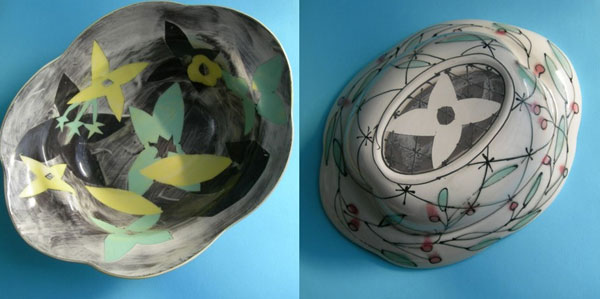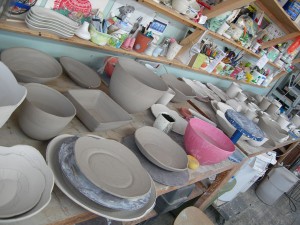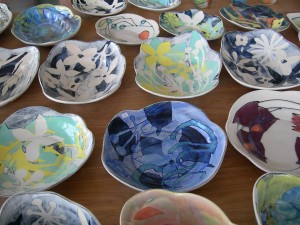As I try to write about Naomi Cleary, so that I can introduce you to her, so that you want to read the interview that follows, I am holding one of her pots in my hand. I am holding it in my hand and I am turning it around horizontal and flipping it vertical, I am running my fingers over it’s smooth surface, I am trying to explain to you why I like it so much.
The Naomi Cleary I have uses a bunch of yellows and blues and greens, there is some grey, the patterning is definitely floral in nature. On my bowl the pattern on the outside is much different then the pattern on the inside, the bottom lip that my bowl rests on is also patterned, a fact that I find out when I turn the bowl over. The bottom has a matte finished, it is unglazed. If I wanted to I could eat ice cream out of my bowl. I find the object I hold in my hands at once simple and complex. I find it beautiful. I am so glad that I am allowed to hold it.
This is the reason I wanted to talk to Naomi, she makes great pots, and I think that’s really something.
You mean real art not pots
Annette Monnier: So I basically invited you here today to ask you why you make pots? I ask because you have a MFA and I think most people make a distinction between functional objects and fine art. . .
Naomi Cleary: You mean real art not pots.
AM: You said it so I didn’t have to, but yes.
NC: I guess a lot of times one thing just leads to another and you go to art school and you take certain classes and you end up liking the material.
For me I was in graduate school and I couldn’t take the jewelry elective because it was full so they put me in crappy ceramics which I did not want to take and I somehow just stayed there. I like the process of making things out of clay. I like working with the material. I’ve always liked domestic objects and the personal relationship we have to the things that we use everyday. The things that we keep close to our bodies.
I think food and eating and dishes and the body and family. . . it’s all wrapped up in there.
Another related fact is that I want to make three-dimensional objects because I want to put a pattern on them. I don’t like patterning flat surfaces, it doesn’t do the same thing for me. I like things that you can pick up and turn over and discover other parts of them by holding and turning. Often times with art objects you can’t do that. The object sits on a pedestal and hangs on the wall and there is really only one way of viewing that object.
Q: Where are objects worth more? A: On the wall.
AM: Not to drive this into the ground, but would you ultimately say that one art form is better then the other functional vs. non-functional?
NC: I think it depends on what you are talking about, but in terms of perceived value I think that anything that hangs on the wall is going to be worth more. You can make a plate or a coaster or you can make a tile that hangs on a wall and the tile that hangs on the wall is always going to be worth more money because that tile is creeping into this fine arts realm where objects are worth more.
AM: Isn’t that frustrating to you?
NC: Yeah. Yeah, it frustrates me. I think that I also have to say that I’m not entirely committed to only dishes though I have been making them for awhile now.
AM: Would you rather be making other objects?
NC: No.
Or yes. Doesn’t. . . sometimes it’s hard to switch gears but I could re-format my studio and just make forms and pattern them.
The amazing bonus
AM: It seems like the heart of your art is the pattern, I know you research patterning and grab source material from a variety of cultures to create your own motifs. It seems really personal. . . for instance you have a motif I’ve often seem on your pots tattooed on your arm.
The painted decoration on your pots is very aesthetically pleasing and it is as you say; it improves it that there’s an inside pattern and something on the bottom to discover when you turn over a cup or bowl. . . it’s just an amazing bonus that you can also use the object.
NC: Isn’t it crazy that it’s like a two for one deal but that means it’s worth less? Just pattern would probably be worth more. It isn’t really even money it’s value. Scratch money, it’s just valued more highly.
It’s all really hard
AM: If I were you I think I’d be a little bitter and I guess I was wondering if you were. . .
NC: Bitter?
AM: Yeah. You make some wonderful art objects and I’m finding that even the words I’m using like “art objects” seem like they might be a little insulting. . . what you make is art, but for some reason there has to be this distinction.
NC: Is artful the same as art? You know, either way is really hard. Art artist, craft artist, functional artist. . . it’s all really hard.
Buying less shoes and making it work
AM: Do you feel like you’re a part of the “indy craft movement”?
NC: I think I’m using that because it’s there to use. I don’t think that my work fits into the general style of let’s say The Renegade Craft Fair. Even though my work is not very traditional ceramic pottery it’s very obviously being made by someone who’s formally trained and has knowledge of ceramic history. It just doesn’t fit.
If I made wood-grained cups with birds on them I would get into all the craft shows I’m sure and those would be great things to sell. . . I don’t really fit in that market and that actually makes me mad sometimes.
AM: Almost.
NC: Yeah. and a lot of times I really struggle with that because I don’t really fit into that market but I don’t really fit into the traditional pottery realm either. I hope I can sneak into both.
It just comes back to what I really want to do and why not spend my energy making the thing that I really want to make? It just comes down to figuring it out and maybe buying less shoes but making the work I want to make.
Buy and see Naomi’s stuff:













